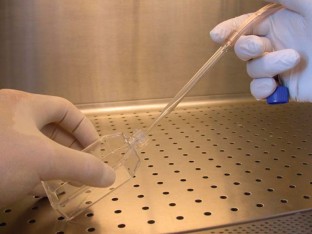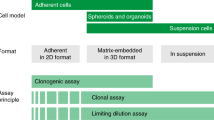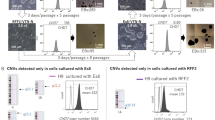Changing medium and passaging cell lines
Cell lines are widely used in biomedical research. This protocol describes the methods used routinely to change the medium and passage the cells. Medium changes keep the cells healthy by providing fresh nutrients, while cell passage or splitting is required to maintain cells in exponential growth. Despite the simplicity of the methods used, each cell line has idiosyncracies. Whether working with one or several cell lines, there is no substitute for knowledge of their needs, including the range of phenotypes and growth patterns under different physical and nutrient conditions. Given the necessary care and attention, most cell lines are easy to maintain and grow.
This is a preview of subscription content, access via your institution
Access options
Subscribe to this journal
Receive 12 print issues and online access
265,23 € per year
only 22,10 € per issue
Buy this article
- Purchase on SpringerLink
- Instant access to full article PDF
Prices may be subject to local taxes which are calculated during checkout

Similar content being viewed by others

Analysis of clonogenic growth in vitro
Article 25 October 2021

Evolution from adherent to suspension: systems biology of HEK293 cell line development
Article Open access 04 November 2020

Improving the differentiation potential of pluripotent stem cells by optimizing culture conditions
Article Open access 19 August 2022
References
- Schaeffer, W.I. Usage of vertebrate, invertebrate and plant cell, tissue and organ culture terminology. In Vitro20, 19–24 (1984). ArticleCASPubMedGoogle Scholar
- Freshney, R.I. (ed.) Culture of Animal Cells 4th edn. (Wiley Liss, New York, 2000).
- Southam, C.M. Homotransplantation of human cell lines. Bull NY Acad. Med.34, 416–423 (1958). CASGoogle Scholar
- Gugel, E.A. & Sanders, M.E. Needle-stick transmission of human colonic adenocarcinoma. N. Engl. J. Med.315, 1487 (1986). ArticleCASPubMedGoogle Scholar
- Lloyd, G. & Jones, N. Infection of laboratory workers with hantavirus acquired from immunocytomas propagated in laboratory rats. J. Infect.12, 117–125 (1984). ArticleGoogle Scholar
- Tedder, R.S. et al. Hepatitis B transmission from a contaminated cryopreservation tank. Lancet346, 137–140 (1995). ArticleCASPubMedGoogle Scholar
- Hummeler, K., Davidson, W.L., Henle, W., LaBoccetta, A.C. & Ruch, H.G. Encephalomyelitis due to infection with Herpesvirus simiae (Herpes B virus); a report of two fatal, laboratory-acquired cases. N. Engl. J. Med.261, 64–68 (1959). ArticleCASPubMedGoogle Scholar
- UKCCCR. UKCCCR guidelines for the use of cell lines in cancer research. Br. J. Cancer82, 1495–1509 (2000).
- Coecke, S. et al. Guidance on good cell culture practice. Altern Lab Anim33, 261–287 (2005). CASPubMedGoogle Scholar
Acknowledgements
We thank Ian Freshney for reading and commenting on this set of protocols.
Author information
Authors and Affiliations
- Department of Surgery, Prostate Cancer Research Centre, Royal Free and University College London Medical School, 67 Riding House Street, London, W1W 7EJ, UK John R Masters
- National Institute for Biological Standards and Control, Blanche Lane, South Mimms, Potters Bar, EN6 3QG, Hertfordshire, UK Glyn N Stacey
- John R Masters





